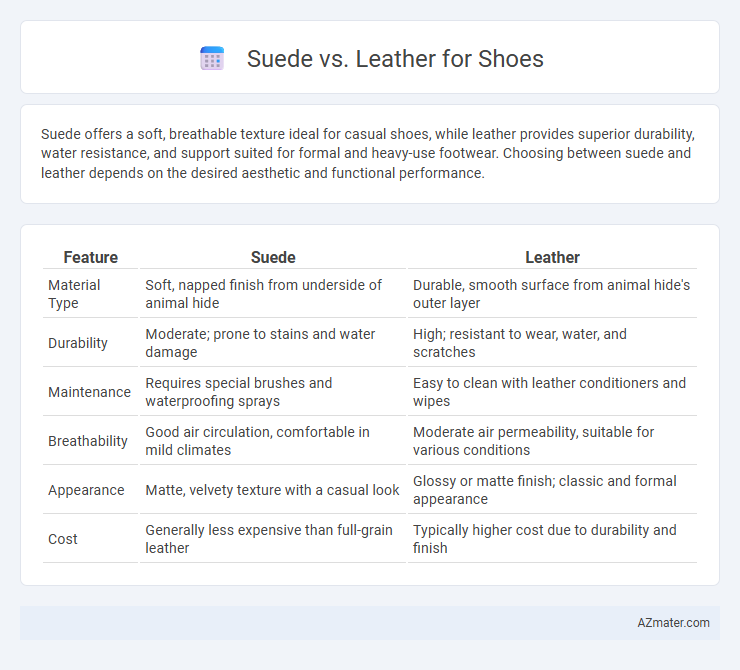Suede offers a soft, breathable texture ideal for casual shoes, while leather provides superior durability, water resistance, and support suited for formal and heavy-use footwear. Choosing between suede and leather depends on the desired aesthetic and functional performance.
Table of Comparison
| Feature | Suede | Leather |
|---|---|---|
| Material Type | Soft, napped finish from underside of animal hide | Durable, smooth surface from animal hide's outer layer |
| Durability | Moderate; prone to stains and water damage | High; resistant to wear, water, and scratches |
| Maintenance | Requires special brushes and waterproofing sprays | Easy to clean with leather conditioners and wipes |
| Breathability | Good air circulation, comfortable in mild climates | Moderate air permeability, suitable for various conditions |
| Appearance | Matte, velvety texture with a casual look | Glossy or matte finish; classic and formal appearance |
| Cost | Generally less expensive than full-grain leather | Typically higher cost due to durability and finish |
Introduction: Suede vs Leather Shoes
Suede shoes offer a soft, velvety texture crafted from the underside of animal hides, providing a distinctive, casual aesthetic ideal for dry conditions. Leather shoes, made from the outer layer of animal skin, deliver durability, water resistance, and a polished appearance suitable for formal settings. Choosing between suede and leather depends on factors like weather resistance, maintenance, and style preferences.
What is Suede?
Suede is a type of leather made from the underside of animal hides, primarily lamb, goat, or calf, characterized by its soft, napped finish that gives it a velvety texture. Unlike traditional leather, which uses the outer skin layer, suede's inner surface offers a more delicate and flexible material, making it popular for stylish footwear. Suede shoes, while elegant and breathable, require careful maintenance to prevent damage from water and stains compared to full-grain leather shoes.
What is Leather?
Leather is a durable and flexible material created by tanning animal hides, primarily from cows, to improve strength and longevity. It naturally resists moisture, offers breathability, and develops a unique patina over time, enhancing both aesthetic appeal and durability in shoes. Leather's robust texture and versatility make it a preferred choice for high-quality footwear that balances comfort and long-lasting wear.
Material Differences: Texture and Appearance
Suede offers a soft, napped texture with a matte finish, created by buffing the inner surface of leather, making it more delicate and prone to staining compared to smooth, polished leather. Leather features a durable, glossy surface with a tight grain structure that enhances resistance to water and wear, providing a more formal and classic look. The tactile contrast between the fuzzy nap of suede and the sleek firmness of leather significantly influences the shoe's appearance and maintenance requirements.
Durability Comparison
Leather shoes generally offer superior durability due to their dense fiber structure and natural resistance to wear, making them ideal for long-term use and harsh conditions. Suede, while stylish and softer to the touch, has a more delicate surface prone to scuffing and moisture damage, which reduces its overall lifespan compared to leather. Proper care and protective treatments can extend the durability of suede, but leather remains the more robust choice for enduring daily wear.
Comfort and Flexibility
Suede shoes offer superior flexibility and breathability due to their soft, napped finish, making them highly comfortable for extended wear in moderate climates. Leather shoes provide more robust support and durability, conforming to the foot over time while maintaining structure, ideal for long-term use and varied weather conditions. Both materials require proper care to preserve comfort, with suede benefiting from protective sprays and leather from regular conditioning.
Maintenance and Cleaning Requirements
Suede shoes require delicate care, relying on a specialized suede brush and eraser to remove dirt while avoiding water, which can cause stains and texture damage. Leather shoes offer more straightforward maintenance with regular cleaning using a damp cloth and conditioning to prevent cracking and keep the material supple. Both materials benefit from protective sprays, but leather's smooth surface allows for easier stain removal and polishing compared to the porous, absorbent nature of suede.
Weather Resistance: Suede vs Leather
Leather shoes offer superior weather resistance due to their dense, natural fibers that repel water and protect against stains, making them ideal for wet or snowy conditions. Suede shoes, made from the underside of animal hide, are more porous and absorb moisture easily, which can lead to damage and stains without proper waterproofing treatment. Weather-resistant leather combined with regular conditioning ensures durability and longevity in diverse climates, unlike untreated suede that requires careful maintenance to avoid water damage.
Style and Fashion Versatility
Suede shoes offer a soft, textured appearance ideal for casual and smart-casual outfits, enhancing style with a matte finish that complements autumn and winter wardrobes. Leather shoes provide a sleek, polished look that suits formal and professional settings, with durability and the ability to age gracefully through patina development. Both materials allow for diverse styling, but leather delivers greater versatility across dress codes, while suede excels in adding a refined yet relaxed aesthetic.
Which is Better for Shoes: Suede or Leather?
Leather offers superior durability and water resistance compared to suede, making it ideal for everyday shoes exposed to various weather conditions. Suede provides a softer texture and a more casual, stylish appearance but requires more careful maintenance to avoid stains and damage. For long-lasting, versatile shoes, leather is generally better, while suede suits fashion-focused footwear for dry, controlled environments.

Infographic: Suede vs Leather for Shoe
 azmater.com
azmater.com